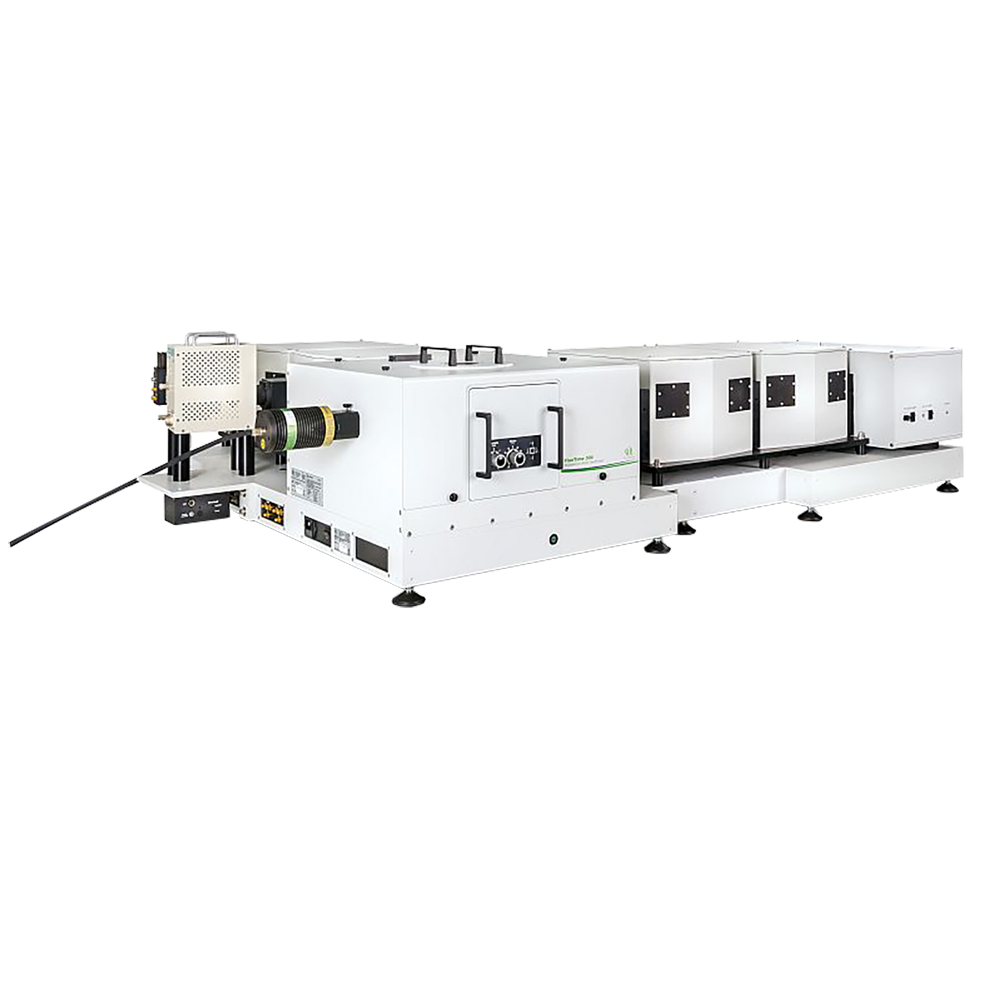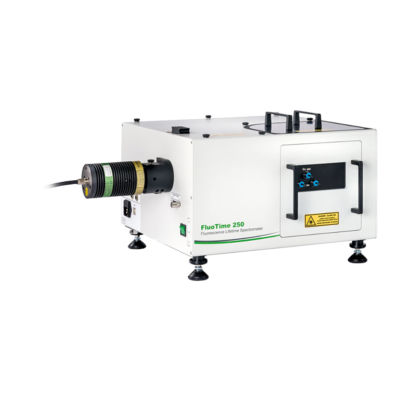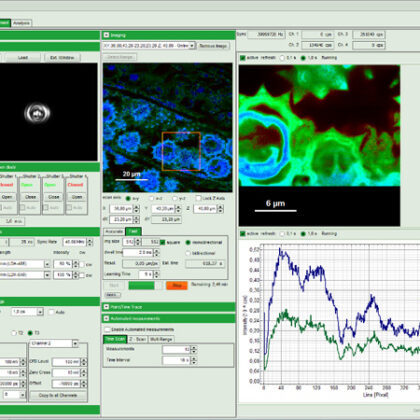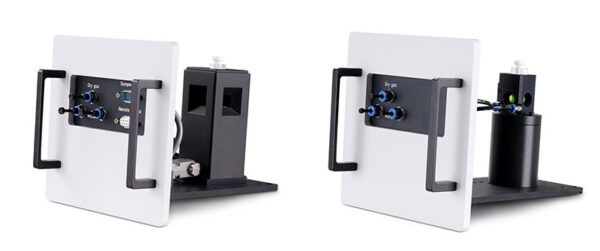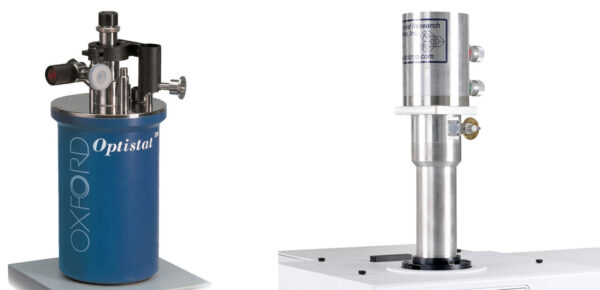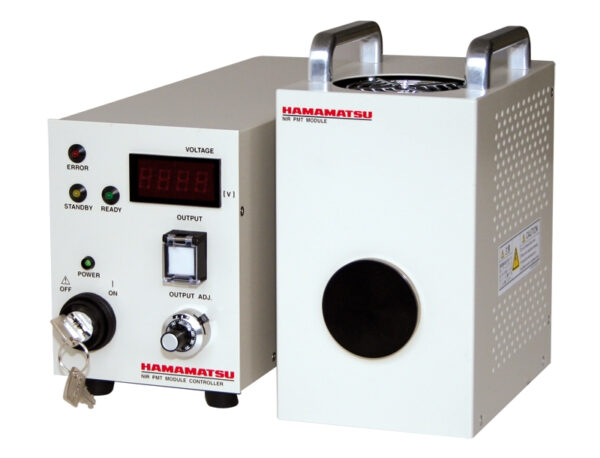High Performance Fluorescence Lifetime and Steady State Spectrometer
- Fully automated system with modular and flexible design
- Time-resolved and steady-state operation
- Easy to use software with application wizards and scripting option
- Lifetimes from picoseconds to milliseconds
- Ultimate sensitivity with 29 000:1 Water Raman SNR
- Double monochromator in excitation and emission available, switchable between additive and subtractive in emission
- The new FluoMic add-on provides a fast, easy, and reliable way to carry out steady-state and time-resolved luminescence spectroscopy with a micrometer sized, positionable observation volume (see the options tab below).
Applications
The FluoTime 250 is a high performance fluorescence lifetime spectrometer suited for studying a broad range of sample in routine and complex applications such as:
- Time-Resolved Fluorescence
- Singlet Oxygen with NIR PMT and suitable bandpass filter
- Time-Resolved Photoluminescence (TRPL)
- Fluorescence Anisotropy (Polarisation)
- Materials Science
- Photochemistry
- LEDs, OLEDs
High performance fluorescence spectrometer
The FluoTime 300 is a fully automated, high performance fluorescence spectrometer for steady-state, life time and phosphorescence measurements. The FluoTime 300 contains the complete optics and electronics for recording steady state spectra and fluorescence decays by means of Time-Correlated Single Photon Counting (TCSPC) or Multichannel Scaling (MCS) from few picoseconds to several seconds. The system is designed to be used with picosecond pulsed diode lasers, LEDs or Xenon lamps (CW and pulsed). Multiple detector options enable a large range of system configurations from the UV up to the IR range. The system features an ultimate sensitivity with 29 000:1 Water Raman SNR. The FluoTime 300 can be used to study fluorescence and phosphorescence decays from few picoseconds to several seconds. With a large range of additional accessories the system is an excellent standard for research and analysis.
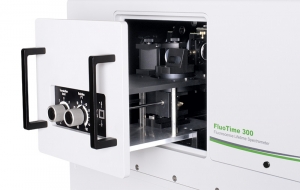
Versatile sample mounting units
A newly designed series of sample mounting units is now available for the FluoTime 300.
Each sample mounting unit is designed around modular sample holders (standard: cuvette, optional: front-face), which allow a quick and easy change between different sample configurations, e.g., liquids, powders, or wafers. Temperature control of the cuvette holder is possible by attaching an external thermostat (tubing for the circulating fluid is pre-installed) or with an optional peltier-cooled single- or multi-cuvette sample holder. A cryostat can be integrated for measurements at low temperature. The range of available sample holders also includes a front face version for samples of up to 2 inch size. The holder permits to change position and angle of the sample with respect to the direction of excitation and detection from outside of the sample compartment. This special feature is extremely useful for an on-line optimisation of the beam position on the sample while the measurement is running.
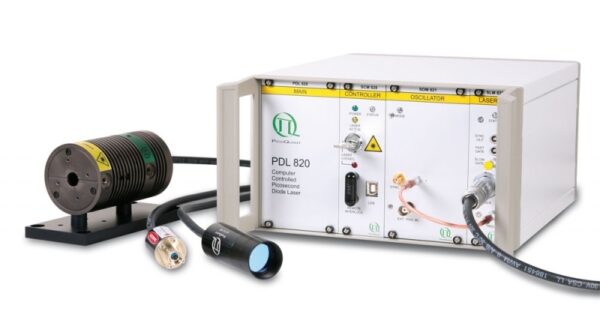
Flexible excitation sources
The FluoTime 300 is designed to be used with picosecond pulsed lasers, LEDs and Xenon flash lamps. Pulsed laser and LEDs are available in a very broad wavelength range from 255 nm to 1550 nm. They can be varied in output power and operated at any repetition rate from single shot to 80 MHz (depending on wavelength) as well as in pulse bursts at low repetition rate intervals. This special feature allows to match the excitation conditions ideally to the sample requirements, from fluorescence with short lifetimes to weak phosphorescence. A specialised driver unit of the PDL Series, the PDL 820, is used to control the individual excitation source. The FluoTime 300 can also be equipped with a Xenon arc lamp and/or a Xenon flash lamp which enable excitation at any wavelength from 200 nm to 900 nm. Along with a dedicated high-resolution monochromator steady-state excitation spectra become possible.
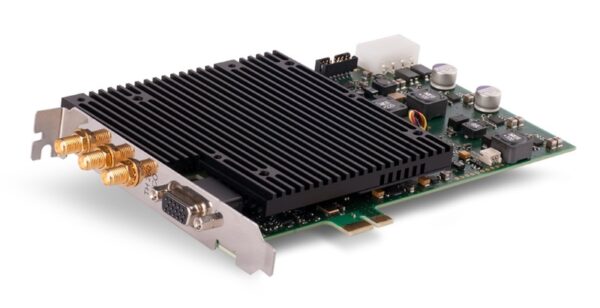
TCSPC and MCS based data acquisition
Several outstanding data acquisition units are available for time-resolved as well as steady-state fluorescence measurements. The TimeHarp 260 PICO offers an adjustable temporal resolution from 25 ps to 5.2 ms and is therefore the perfect choice for measuring steady-state and time-resolved emission with lifetimes ranging from a few ten picoseconds up to several milliseconds. The TimeHarp 260 NANO is a dedicated MCS board that has a minimum base resolution of 250 ns and no dead time between channels. The TimeHarp 260 NANO is therefore ideally suited for steady-state measurements or for lifetime measurements up to the second time scale. Any of these data acquisition units are the perfect match for systems equipped with a detector of the PMA Series or PMA Hybrid Series.
For measuring ultrafast dynamics the PicoHarp 300 offers an even better temporal resolution (4 ps) and is therefore recommended for FluoTime 300 systems equipped with a fast PMA Hybrid PMT (-06 or -07) or MCP-PMT detector. In that case even dynamics of tens of picoseconds can be resolved.
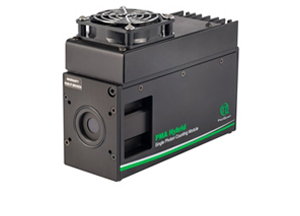
Several available detector types
The FluoTime 300 uses single photon counting detectors of various types, attached to an exit slit of the emission monochromator. The system can work with one or two detectors. The available detectors are either photomultiplier tubes (PMA Series or NIR-PMTs), Hybrid-PMT modules (PMA Hybrid Series) or Microchannel Plate Photomultiplier Tubes (MCP-PMTs). The detectors offer picosecond temporal resolutions and cover different spectral ranges between 180 nm and 1700 nm. Each detector includes an electro-mechanical shutter, optional cooling, and an overload protection that can be operated from the system software.
NEW: -07 and -42 cathodes with spectral ranges between 220 and 870 nm, detection efficiency up to 25 %
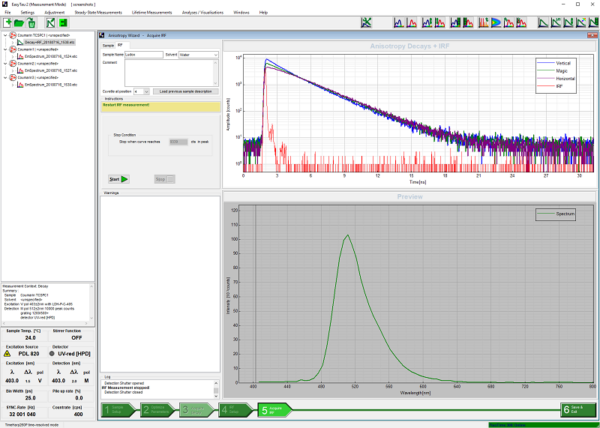
System software “EasyTau 2”
The FluoTime 300 features an intuitive and easy-to-use system software. All measurement data files and all related analysis results are stored in a clearly arranged workspace, which resembles the familiar tree structure of a hard drive directory. Data dependencies are thus visible at first glance. Steady-State and time-resolved measurements can be performed alternatively from the same software interface.The software features three data acquisition possibilities. Specifically designed application wizards guide the user through the necessary optimisation steps for performing typical measurement tasks such as fluorescence lifetime measurements, anisotropy measurements, collection of emission spectra or Time-Resolved Emission Spectra (TRES). For those familiar with the technique, a customised measurement mode for full instrument control is also available. More sophisticated application tasks, like, for example, alternating between time-resolved decays and steady-state spectra at different temperatures over night, can be easily performed through scripted data acquisition using the integrated scripting language of the EasyTau 2 software.
Steady-state and time resolved data can by analysed through the same software interface. EasyTau 2 provides both basic data manipulation (such as arithmetic, derivation, integration, or smoothing) and fitting functions. The software’s global decay analysis features an easy-to-use graphical user interface that is capable of producing presentation-ready numerical and graphical output. Both tail and iterative reconvolution fitting routines with nonlinear error minimisation are supported. Various exponential decay models (up to fifth order) or rate constant distribution models can be fitted to the observed decay to determine the fluorescence lifetimes or to study fluorescence anisotropy. Robust error analysis can be carried out with the bootstrap method.
Course on time-resolved fluorescence
PicoQuant annually holds the European short course on “Principles and Applications of Time-resolved Fluorescence Spectroscopy”. The course is intended for individuals wishing an in-depth introduction to the principles of fluorescence spectroscopy and its applications to the Life Sciences. The course is held in cooperation with Prof. J.R. Lakowicz from the Center of Fluorescence Spectroscopy (CFS) in Baltimore and consists of lectures as well as instrumentation and software hands-on training.
































